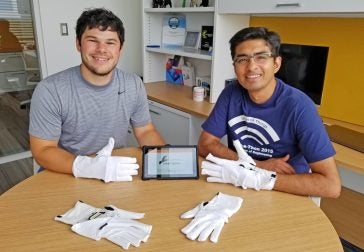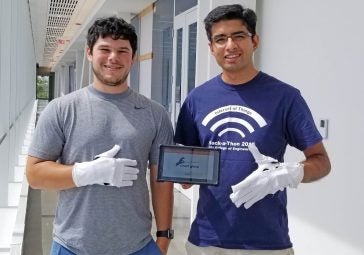
By Neil Nachbar
Nearly 930,000 people in the United States will have Parkinson’s disease by 2020, according to a Parkinson’s Foundation study. That figure is projected to increase to 1.2 million by 2030.
A smart glove that can collect data based on the movements of those living with the disease and other movement disorders is being developed by University of Rhode Island Associate Professor Kunal Mankodiya. The data will help doctors make informed decisions on the type of exercises patients should perform and the medications to prescribe.
The two-year grant for $249,977 was awarded by the National Science Foundation (NSF) through its Partnerships for Innovation Technology Translation (PFI-TT) program. The program enables researchers to further develop a previously NSF-funded project, such as the smart glove, that has demonstrated the potential for commercial success and societal impact.

From Prototype to Product
“This funding will enable us to take a deep-dive into the world of fusing different domains, including conductive fabrics, wearable electronics, human-factors design, and smart textile manufacturing,” said Mankodiya. “I’m glad that the NSF created such grant programs where innovative technologies could find their way to the marketplace over the years.”
Mankodiya and the students in his Wearable Biosensing Laboratory designed the first prototype of the smart glove in the summer of 2016.
“We’ve performed significant research on the smart gloves over the years,” stated Mankodiya. “We decided that it’s time to transition this technology from research to the market. However, the transition is not straightforward. It will require very focused, narrow research to finalize the physical, digital and analytical components of the smart gloves.”
Nick Constant, who is pursuing a doctorate in electrical engineering at URI, has worked on the smart glove project from its inception and will explore commercial opportunities for the device.
“I spent time building the proof-of-concept glove in the lab for the original NSF CAREER grant,” said Constant. “Its ultimate outcome seemed clear from the beginning, but building a new technology takes time and testing. We have seen this glove go from a hopeful idea to gaining traction in reality through different design iterations and consultations with stakeholders.”
From Grad Assistant to Entrepreneur
Just as the glove has evolved over time, so has Constant’s role.
“I suppose my involvement has changed from being just the graduate assistant to an entrepreneur,” Constant said. “Kunal and I wrote the new grant side-by-side and plan to pursue the research in the same manner. We will work with some partners who are familiar with the manufacturing process, supply chain and medical device regulations.”
According to Constant, they are in the running for a Rhode Island Commerce Corporation Innovation Voucher, which would enable them to partner with someone on the design aspect of the glove.
“Our expected outcome is a glove that can be shown to investors that has a manufacture-friendly design, along with a practical price point,” said Constant, who is from West Warwick, Rhode Island.
Medical Collaboration
Another collaborator on the project will be neurologist Umer Akbar, who is the co-director of the Movement Disorders Program and the Deep Brain Stimulation Program at Rhode Island Hospital. He is also an assistant professor of Brown University’s medical school.
Akbar, who has worked with Mankodiya on a couple of other projects, specializes in caring for patients with Parkinson’s disease.
“The challenge with studying the many symptoms of the disease is that they fluctuate throughout the day,” said Akbar. “The short window physicians have into their patients’ lives is often inadequate to verify the symptoms, so we sought to develop wearable technology that can remotely and objectively provide clinical data which can help us better treat our patients.”
Using a sample size of 20 to 30 Parkinson’s disease patients, a pilot study will be conducted in Mankodiya’s lab, at Rhode Island Hospital and with the gloves being worn in the patients’ homes.
Living with Parkinson’s
There is one Parkinson’s disease patient who has already worked with Mankodiya and Constant. Andrea Hopkins, ’68, who is a former assistant vice president of public affairs at URI, has tested smart gloves in the researchers’ lab for a few years.
Diagnosed with the disease in 2002, Hopkins is looking forward to the next phase of the smart glove project.
“There is no cure for Parkinson’s disease, but if doctors can monitor their patients remotely using the smart glove, it would enable them to assess how the medications are working and then make adjustments if necessary,” said Hopkins. “This could also eliminate the need for a follow-up appointment, saving the patient and the doctor time.”
Hopkins believes she’s been able to slow down the progression of the disease due to her exercise regimen, which includes physical therapy in a pool, strength training, yoga, four-mile walks and LSVT BIG, which is a program that trains improved movements for small motor tasks, such as buttoning a shirt and large motor tasks, such as getting up from a chair.
Perhaps someday, patients such as Hopkins will receive the most optimal treatment plan from their doctors based on instant feedback from the smart glove.
